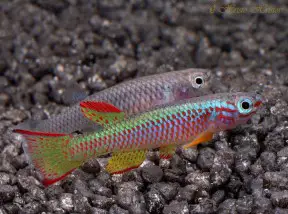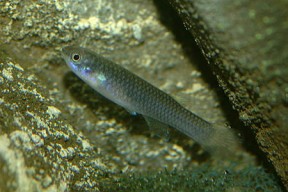Aphyosemion gabunense
Gabon Lyretail, Gabun Prachtkärpfling (DE)
Etymology
Aphyosemion: from the Greek aphúe (Gr. ἀφύη), meaning ‘a small fish’, and semeion (Gr. σημεῖον), meaning ‘banner, flag’, in reference to the “ornamented, often lyre-shaped” caudal fin in male individuals of genus members.
gabunense: named for the country of Gabon in combination with the Latin suffix -ense, meaning ‘of, from’ (a place).
Classification
Order: Cyprinodontiformes Family: Nothobranchiidae
Distribution
Described from close to the city of Lambarené, western Gabon, and thought endemic to the lower Ogooué river basin, including the tributary Ngounie drainage.
Habitat
Swamps, small streams and pools.
Maximum Standard Length
40 – 50 mm.
Aquarium SizeTop ↑
A tank or container with base measurements upwards of 45 ∗ 25 cm is acceptable for a pair or trio.
Maintenance
A dark substrate should be used, ideally peat moss or similar. Decor-wise, the tank should have dense areas of planting and pieces of wood to serve as cover. The use of floating plants to further diffuse the light is also recommended. This species is an accomplished jumper so the cover must be very tight fitting.
Water Conditions
Temperature: 72-77°F (22-25°C)
pH: 6.5-7.2
Hardness: 5-15°H
Diet
Small live or frozen foods such as Daphnia or bloodworm are preferred although it will also accept good quality flake in most cases.
Behaviour and CompatibilityTop ↑
A. gabunense can be kept in a community setup provided tankmates are chosen with care. This is a very peaceful, shy species and will easily be outcompeted by more vigorous fish. Potential choices include small characins, rasboras and dwarf cichlids, Corydoras, small Loricariids and peaceful Anabantoids.
Sexual Dimorphism
Males are much more colourful than females and have longer dorsal, caudal and anal fins.
Reproduction
There exist several different methods of spawning it, and much is down to personal preference. A pair can easily be spawned in an aquarium as small as 12″ x 8″ x 8″. It’s often recommended that this fish be spawned in trios but we have always found that brood sizes tend to be lower when it is bred this way, perhaps due to the fish that is not spawning eating some of the eggs.
Many breeders do not use filtration in killi breeding setups but the addition of a small, air-driven sponge filter to prevent stagnation is a good idea. Water should be slightly acidic pH 6.8-7.0 with a temperature of 70-75°F and should be unlit.
The fish should be conditioned on a varied diet of live and frozen foods. We recommend keeping the 2 sexes apart in separate conditioning tanks and selecting the best male and plumpest female before placing them in the spawning tank. This method allows females to recover between spawnings. A. g. gabunense will deposit eggs either in the substrate or clumps of vegetation in nature and therefore the spawning medium can either be a layer of peat moss on the floor of the aquarium, clumps of fine-leaved plants such as java moss or spawning mops. We recommend a bare-bottomed setup with spawning mops for both ease of maintenance and egg collection.
If water conditions are good and the fish are well conditioned, spawning should present no real problems. The eggs can be left in the aquarium to hatch with the parents but some eggs and fry may be eaten. If you want to raise a good-sized group, the eggs should be removed. 10-20 eggs are deposited daily for around 2 weeks and these should be removed gently as they are noticed. Each pair should only be allowed to spawn for a week or so before being returned to the conditioning tank as the spawning process is hard on the fish (particularly the female) and they can become fatigued and weak if left for too long.
Once removed, the eggs can be incubated either in water or by placing them on a damp layer of peat moss in a small container (margarine tubs are ideal). Less eggs tend to fungus using the latter method, although fungussed eggs should still be removed.
If incubating in water, the eggs can be transferred to a small aquarium containing water from the spawning tank to a depth of 1-2 inches to which has been added 1-3 drops of methylene blue depending on volume. This container should be kept under darkness (the eggs are very sensitive to light) and checked daily for fungussed eggs, which should be removed with a pipette. The eggs will hatch in 18-22 days depending on temperature.
If incubating on peat moss, place the container in a warm, dark place and simply leave it for 14 days, after which the eggs will be ready to hatch. If you are spawning several species or multiple broods, it is a good idea to label each container with the date, hatching date, species and number of eggs to prevent any disasters. Hatching can usually be induced by simply placing the eggs in the raising aquarium after 14 days, where the wetting of the eggs stimulates hatching. If this fails, blowing gently into the water through a straw or piece of airline can trigger hatching.
The fry are tiny and initial food should be infusoria. If using the peat moss incubation method, the raising tank can be ‘seeded’ a few days prior to hatching by adding a couple of drops of liquifry or green water. Otherwise, add small amounts as required. After 2 days they can be fed brine shrimp nauplii or microworm with the introduction of larger and frozen varieties after 2 weeks or so. The water must initially be kept very shallow but the level can be raised as the fry grow.
Extreme care must be taken regarding water quality in the raising tank as the fry are very susceptible to velvet disease. This is quite a slow-growing species and the fry should be fed twice a day with small water changes every 2-3 days for the best growth.
NotesTop ↑
A. gabunense is a good beginner’s killifish as it is not an annual species, being found in permanent bodies of water in nature.



